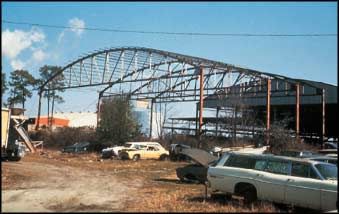Know where they are & how they fail
This is a steel bowstring truss. In trusses, the top chord is under compression like a long, slim column. Long, slim columns resist buckling with the help of braces placed regularly along their length. If a panel point connecting a brace to the top chord fails (e.g., a rivet pops out), the gap between two panel points doubles, and the chord can’t resist buckling.
 |
The Wichita (Kan.) Fire Department sent a second alarm as they turned out for a 1971 fire in an automobile shop with a steel-trussed roof because of the dramatic loom-up of smoke. Four firefighters (including the chief) died in the subsequent roof collapse, which was accelerated by heavy auto parts stored on the truss’ bottom chord.
The loom-up is a signal the building may well demand a defensive attack. If the loom-up is due to a large, outdoor rubbish fire, no problem. However, as Roman historian Horace told us, “Where there is smoke, there is fire” (in Latin, of course). We can elaborate and say, “Big smoke means big heat, and steel fails.”
The worst firefighter truss disaster was the collapse of a steel parallel-chord truss, which killed 13 Brocton, Mass., firefighters in the 1940s. More recently, Wakefield (Mass.) firefighters properly preplanned a lodge hall and were out of the building when a similar truss failed.
Look at every building from the firefighter-hazard point of view. Do you know where steel trusses are hidden in the attics of your buildings? Get out and study the roof of every wide-span building in your response area. If possible, plan to cool the steel from a safe location. Water on hot steel does not cause collapse, though this myth was recently presented at the National Fire Academy. See BCFS3 Chapter 7 — Steel Construction and Chapter 12 — Trusses for more detailed information.
Francis (Frank) L. Brannigan, a fireground commander in the 1940s and a fellow of the Society of Fire Protection Engineers, was named one of the 20 most influential people in the fire service by Fire Chief Magazine. For 37 years, Brannigan has defined building hazards for firefighters. His book, “Building Construction for the Fire Service, Third Edition,” is available from the NFPA.











